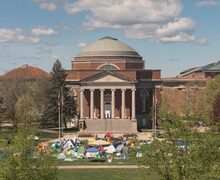SU won’t place dorms with coronavirus in wastewater on lockdown
Courtesy of Caitlin Mogan
SU personnel designed and constructed the testing machines.
The Daily Orange is a nonprofit newsroom that receives no funding from Syracuse University. Consider donating today to support our mission.
After graduating from the Master’s in Public Health program at Falk College, Pruthvi Kilaru expected to begin working in a pediatric clinic.
When those plans fell through due to the coronavirus pandemic, David Larsen, an associate professor of public health at Syracuse University, asked Kilaru if he would be interested in implementing wastewater testing as part of the university’s fall reopening plan. Kilaru now runs the program’s day-to-day operations, overseeing a system that has identified several traces of the virus in residence halls.
“What this pandemic has taught me is that people are willing to help,” Kilaru said. “And I’m willing to do the same.”
Kilaru and several other student workers have operated the wastewater testing system, which has turned up coronavirus traces in several SU dorms this semester, leading to the university placing some facilities under quarantine. Moving forward, the university is not going to quarantine all buildings that show traces of the virus in their wastewater, Larsen said.
“Going forward, we don’t anticipate quarantining dorms based on wastewater again,” he said. “That was a learning experience for everybody.”
The university closed Ernie Davis Hall and instructed residents to quarantine in their rooms in early September after detecting possible traces of COVID-19 in the facility’s wastewater. Saliva tests administered to residents and employees who work in the building came back negative.
Wastewater testing has also turned up traces of the virus in Sadler and Day halls. The university has attributed some of those traces to people who previously had the virus and continued shedding remnants of it after they were no longer contagious.
Instead of shutting down all buildings where officials find traces of the virus in wastewater, the university will now look for spikes in the virus’s presence that could indicate a new case in the facility, Larsen said.
SU officials, local experts and students have been working to develop the wastewater surveillance system since the spring.
The sampling system, which Kilaru designed, built and published himself, uses a mechanical pump inserted into sewer pipes to draw out samples of a building’s wastewater. The pump collects a sample every 15 minutes, and the samples are combined into one composite sample.
“The reason we do that rather than just pulling out a sample at a random time every day is because it’s more representative of how people use the system,” Kilaru said.
Student workers then draw 250 mLs of the larger composite sample stored inside a box that houses the pump, he said. SU sends these to a lab for testing, with test results coming back within two days.
SU collaborated with SUNY-ESF and SUNY Upstate Medical University to implement the sampling system. Kilaru helped write procedures for wastewater testing at the county level.
Onondaga County has set up several wastewater surveillance points as part of a state-funded pilot program. SU partnered with the county to include popular off-campus student housing locations, including the Westcott neighborhood and The Marshall apartment complex, in the program.
Four student workers from the university’s contact tracing team service the wastewater samplers daily. Students replace the pump’s battery each time it takes a sample and add ice to keep the samples cold.
Some of the university’s 30 contact tracers will also occasionally step in to assist with the testing, Larsen said.
Since the live virus is not present in wastewater, students who assist in the sampling process aren’t at risk of contracting COVID-19, Kilaru said. SU provides student workers with personal protective equipment and encourages them to wear long sleeves and pants when drawing wastewater samples, he said.
Wastewater testing has allowed SU to become familiar with how quickly the virus travels on campus and how many chains of transmission there are, Larsen said.
“The wastewater surveillance is like our smoke detector,” he said. “When it goes off, we send in the fire department — that’s our testing crew. We are acting before we allow it to be widespread throughout a dorm.”
Published on September 30, 2020 at 10:51 pm
Contact Michael: [email protected] | @MichaelSessa3





